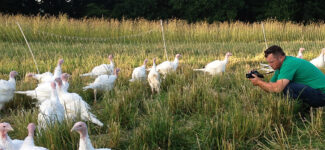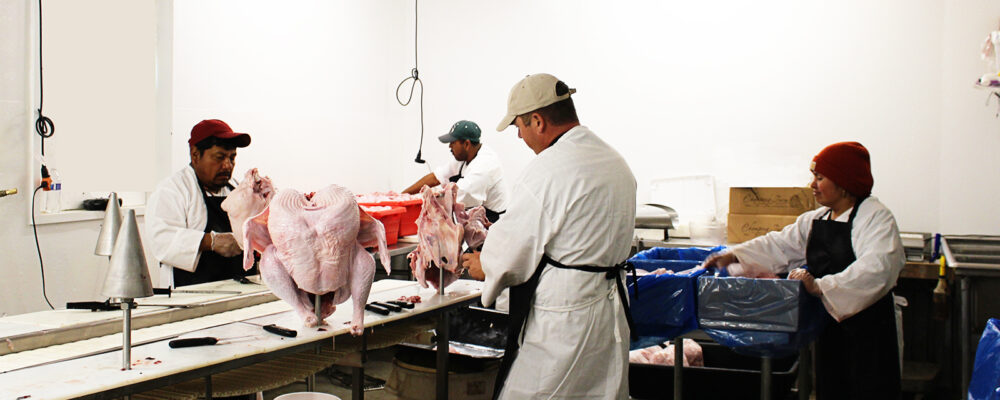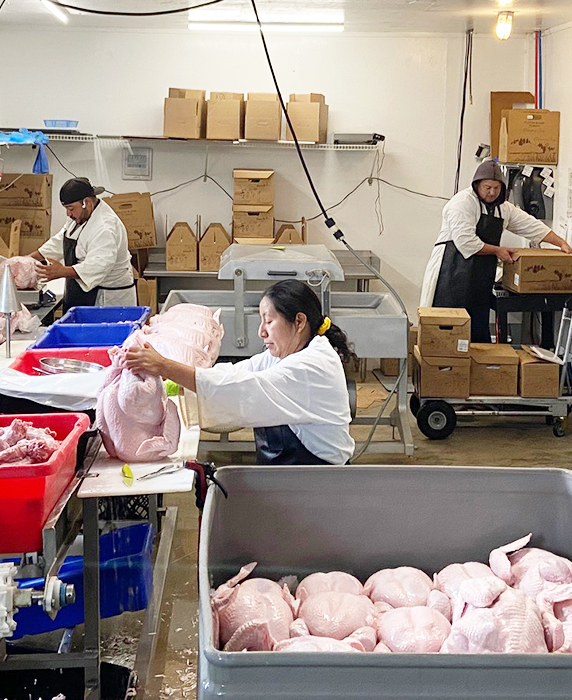No products in the cart.
Welcome to our website!
We're so happy you stopped by. Please let us know if you have any questions for us.

We're so happy you stopped by. Please let us know if you have any questions for us.
Don't forget to sign up for our mailing list to receive periodic emails about new products and upcoming events! You will also receive a Coupon Code for your first order.

Life on the pasture is great compared to their confinement cousins, but the birds do have one bad day. Having processing on farm makes that day as low stress as possible from their perspective, and yes, stress levels do affect meat quality. Our priorities in the plant are to continue the humane treatment of the birds and to practice efficient processing techniques while insuring that proper food safety measures are taken and temperature targets obtained. We are focused on maintaining our high quality while taking care of our employees and fulfilling customers’ needs and expectations. These are key factors of sustainability for us.
Our employees are trained how to efficiently and safely handle the poultry with a focus on minimizing stress to ensure that the process goes as smoothly as possible. We use the industry method of water-bath stunning to ensure animal welfare standards are upheld throughout. Another primary focus is on food safety using continuous refrigeration and vacuum seal technology.
For us expanding our operation to include processing wasn’t just about bird health, food safety issues or scheduling. It goes back to our goal of providing local, sustainable turkey in the manner in which folks use it. 70% of turkey consumed in the United States is eaten as cuts, ground or deli meat. Of all sandwich meat consumed in the US, turkey is the preferred choice and commands 31% of market share. With a lack of processing infrastructure available in Oregon, it wasn’t possible to fulfill the need in the cut market. So we built a facility that has the capacity to handle our processing needs.
We raise Broad Breasted White Turkeys which were developed for high meat yields. Heritage breeds grow extremely slowly and are not designed to produce meat in volume. In order to provide nutritionally dense turkey to customers in the manner in which it is consumed in the United States requires us to use newer breeds and technology. Turkeys were raised outdoors for decades but the turkey industry left Oregon in the 1990’s. We are combining tried and true methods with new technology to produce turkey in a sustainable and economical manner. Most turkey is consumed in the form of lunch meat which is traditionally made from breast meat or more unfortunately, mechanically separated meat.
We raise heavy toms for their overall ability to develop high meat yields especially in breast meat. These guys will grow out to nearly 50 pounds with about 15 of that being in breast meat. In the first few weeks of growth, they put their energy into strong legs and bone structure so their frame can easily handle their muscle mass. By six months old, they have reached optimal weights. They spend up to four months on pasture foraging, stomping down grasses and spreading their fertilizer which contributes to our regenerative practices. As efficient as they are at growing, this means they don’t do well being processed at smaller sizes because they are gangly until about 30 pounds when they really start to build out their full shape. This is why we like to raise hens for our whole holiday birds. Hens don’t put energy into a huge frame so they more evenly gain weight at smaller sizes and have a really nice presentation for the table. They especially do better in the colder fall weather where they’ll put on a nice even layer of brown fat as the days turn cold. We raise hens for holidays and for smaller cut up parts such as drumsticks or single breasts with skin.

After the heavy toms are processed, they are broken down into “primals”. First the breasts are removed each weighing about 7 pounds. Most of these are trimmed to consistent sizes individually netted and sold as boneless, skinless breast roast to wholesale buyers who roast and slice them for lunch meat. We also take the breast and slice it into cutlets or dice it into 1″ cubes, both extremely versatile in the kitchen.
Then we remove the dark meat Thigh…
We use whole muscle parts to make our ground turkey which consists of 70% dark meat and 30% light. This comes from the scapula, drumsticks and trim meat.
No products in the cart.
